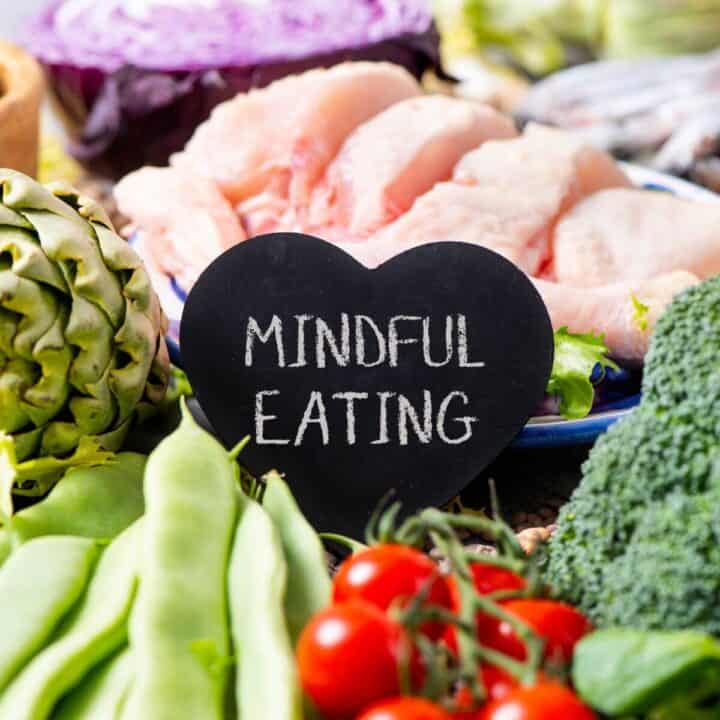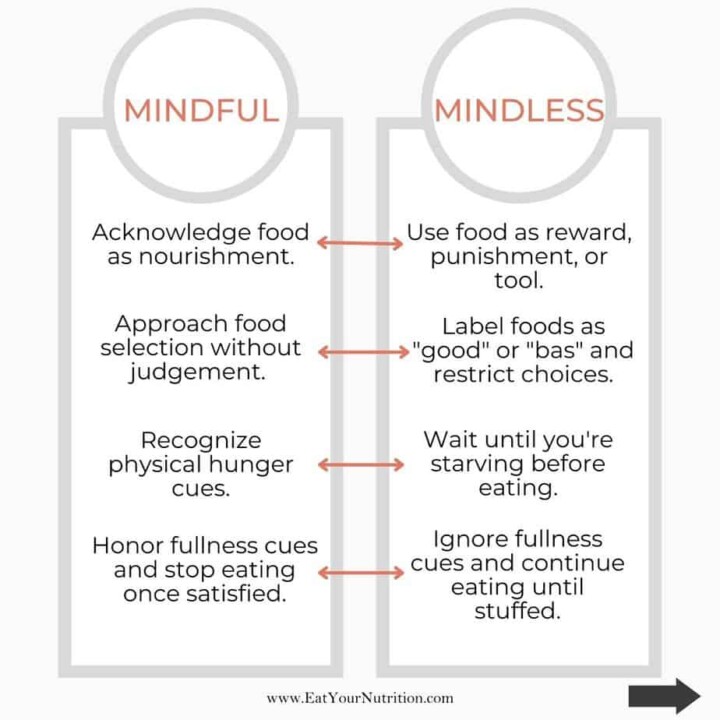Do you ever think about the way you eat? For example, do you grab just anything on the way to work and eat it in the car? Do you try to eat while checking emails or working? If you are not being intentional or mindful about how and what you eat, it may be impacting your digestive system. So, what exactly is mindfulness eating? Let's do a mindful eating 101 discussion.

Table of Contents
⁉️ Mindful Eating 101
Mindful eating is simply eating with intention and paying attention to your food, including when what, and how much you eat.
Research has shown that mindful eating improves digestion, eating habits, and overall health. It can also have a positive impact on the emotional and psychological aspects of eating.
🩺 How Mindless Eating Affects Your Health

Poor Digestion
Thinking about food before eating actually prepares your mind and body for the first stage of digestion, because the brain starts to anticipate the smell and taste of the food, stimulating digestive juices. It also triggers the release of enzymes that help break down the food.
However, if you eat mindlessly and don't pay attention to your food, then your brain doesn't prepare properly. You have actually cheated your brain, and it may lead to poor digestion and weight gain.
Stress And Mindful Eating
So, what does stress and mindfulness eating have to do with one another? Eating while working can increase the stress hormone cortisol.
This hormone suppresses the production of enzymes, stomach acid, and saliva needed to digest food, resulting in undigested food, lost nutrients, acid reflux, gas, and bloating.
Over-Eating
Mindless eating often leads to over-eating. Inhaling food quickly prevents you from noticing your body's signals that it is full.
It can result in poor digestion or even complications with your digestive system, including inflammatory bowel disease. Our ability to digest food and absorb nutrients is also affected by stress, hormones, gut microbial imbalance, toxins, and food sensitivities.
📝 Mindful Eating 101
Practicing mindful eating is not as intimidating as it sounds, and the more you practice, the more effortless and less of a process it becomes. It does not have to be long and drawn out, but mindful eating should be precisely that-mindful, intentional, and focused.
So, what can we do to put mindful eating into practice? Here are a few simple ways to start eating more mindfully.
Plan Your Meals
- Begin by planning out your meals, or at least what you are going to eat for your next snack or meal.
- Planning ahead gives your mind and body a chance to prepare for and anticipate what you will be consuming.
- Planning also prevents you from grabbing something unhealthy at the last minute that you will end up scarfing down in a hurry and allows you to set aside enough time to actually enjoy your meal. This is beneficial when practicing mindful eating.
Sit Down And Remove Distractions
- Whether you are at home, the office, or even a restaurant, make it a point to prepare your place to eat.
- Sit down at a table or desk and set phones, computers, or work files to the side.
- This is not the time to check your social media or cram in one more item on your to-do list.
- This is your time to fuel and nourish your body.
📥 GET THIS RECIPE IN YOUR INBOX 📥
Eat With Intention
- Focus on your meal.
- What are you eating? What are the flavors? If you made it yourself, can you taste the spices you used? What is the texture?
- Pay attention to how you cut the food. After you take a bite, set down your utensils. Chew for several seconds. Don't gulp.
- After you swallow, notice any flavors that linger in your mouth.
- Then, pick up your utensils and prepare another bite.
Reflect On Your Eating Habits
- Food should be fuel for your body and should be something you enjoy.
- Reflect on your eating habits. If your habits do not reflect this, your eating might require a little more mindfulness.
I hope that I helped explain what is mindful eating in a way that is helpful. You can read more about how to use meditation for mindful eating in the article below.

🍕 Are You A Mindful Or Mindless Eater?
Unlike sleeping and breathing, eating requires deliberate engagement on our part. We need to make decisions on what we gather, shop for and select.
That's why mindful eating is so important - it allows us to make meaningful, clear choices about the food we're eating and why. Mindfulness versus mindless eating. Stay present.

💚 Core Principles Of Mindful Eating
Mindful eating can be a challenging topic for many people, mainly because they are uncertain of what it actually means. The core principles of mindful eating are simple.
⁉️ Mindful Eating Versus Mindless Eating
- Bring awareness to the nourishing properties of food through the process of food preparation and consumption.
- Select enjoyable and nutritious foods.
- Acknowledge food preferences non-judgmentally, and give permission to enjoy fun foods.
- Recognize and honor physical hunger and satiety cues. Begin to understand your cravings and why they are occuring.
- Use wisdom to guide eating decisions.

Mindful Eating
- Acknowledge food as nourishment.
- Approach food selection without judgement.
- Recognize physical hunger cues.
- Honor fullness cues and stop eating once satisfied.
Mindless Eating
- Use food as reward, punishment, or tool.
- Label foods as "good" or "bad" and restrict choices.
- Wait until you're starving before eating.
- Ignore fullness cues and continue eating until stuffed.
🗣️ Let's Discuss Mindful Eating Versus Mindless Eating!
I would love to hear your experience with mindful eating and how this has impacted your health. Let me know in the comments below.
You can also connect with me @EatYourNutrition on Instagram. I love seeing your photos. #EatYourNutrition #LauraVillanueva


















Comments
No Comments